Mohamed Abouelenen with Menna Zaki in Cairo,AFP•October 3, 2020
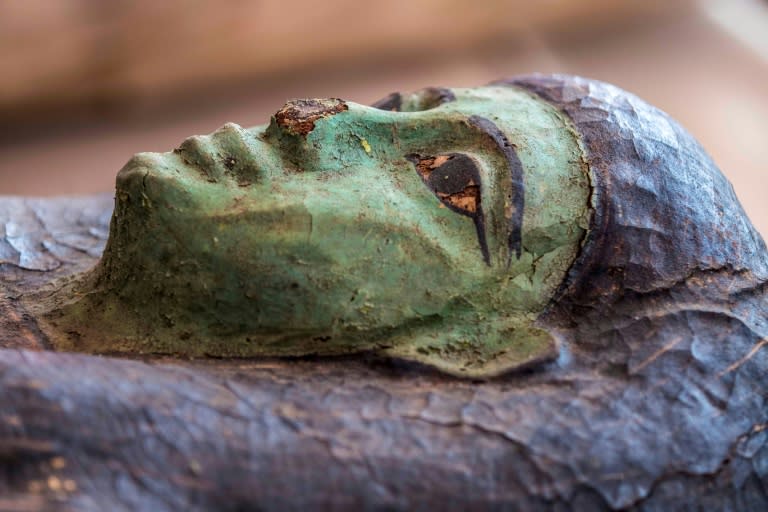
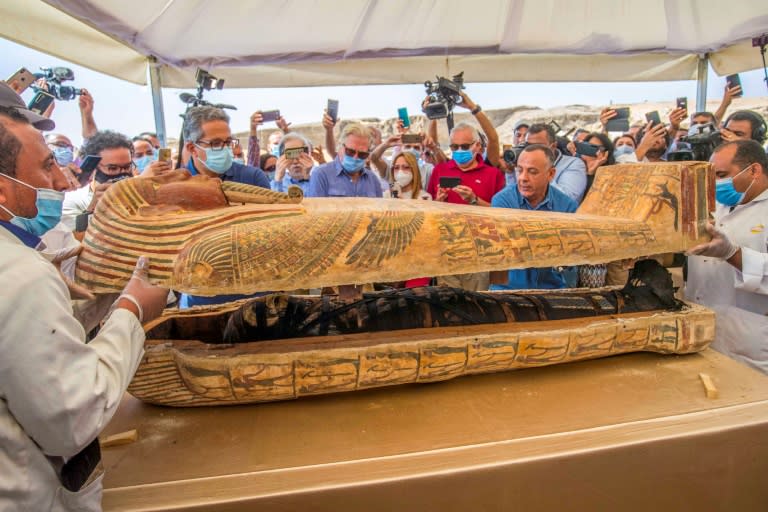
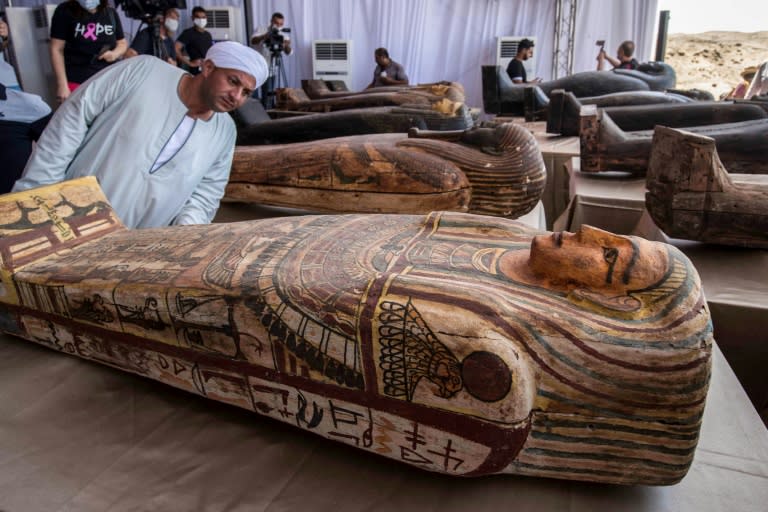
3 / 3
Egypt unveils coffins buried 2,500 years ago
The discovery of the coffins is the first major announcement since the outbreak of Covid-19 in Egypt, which led to the closure of museums and archaeological sites for around three months
Archaeologists in Egypt said Saturday they had found 59 well-preserved and sealed wooden coffins over recent weeks that were buried more than 2,500 years ago.
Opening one of the ornately decorated sarcophagi before assembled media, the team revealed mummified remains wrapped in burial cloth that bore hieroglyphic inscriptions in bright colours.
The dramatic find was unearthed south of Cairo in the sprawling burial ground of Saqqara, the necropolis of the ancient Egyptian capital of Memphis, a UNESCO World Heritage site.
"We are very happy about this discovery," said Mostafa Waziri, secretary general of the Supreme Council of Antiquities.
Since the find of the first 13 coffins was announced almost three weeks ago, more have been discovered in shafts at depths of up to 12 metres (40 feet).
An unknown number of additional coffins may still lie buried there, the tourism and antiquities minister, Khaled al-Anani, said at the site, near the 4,700-year-old pyramid of Djoser.
"So today is not the end of the discovery, I consider it the beginning of the big discovery," he said.
The coffins, sealed more than 2,500 years ago, date back to the Late Period of ancient Egypt, from about the sixth or seventh century BC, the minister added.
Excavations in Saqqara have in recent years unearthed troves of artefacts as well as mummified snakes, birds, scarab beetles and other animals.
- Major discovery -
The discovery of the coffins is the first major announcement since the outbreak of Covid-19 in Egypt, which led to the closure of museums and archaeological sites for around three months from late March.
Dozens of statues were also found in the area including a bronze figurine depicting Nefertem, an ancient god of the lotus blossom.
Preliminary studies indicated the sarcophagi likely belonged to priests, senior statesman, and prominent figures in the ancient Egyptian society of the 26th dynasty, Anani said.
All the coffins would be taken to the soon-to-be-opened Grand Egyptian Museum on the Giza plateau, he added.
They would be placed opposite a hall hosting 32 other sealed sarcophagi for priests from the 22nd dynasty, which were found last year in the southern city of Luxor.
The opening of the Grand Egyptian Museum, which has been delayed several times, is planned for 2021.
The museum will host thousands of artefacts, spanning multiple eras of Egypt's history, from the pre-dynastic to the Greco-Roman period.
Egypt hopes a flurry of archaeological finds in recent years and the Grand Egyptian Museum will boost its vital tourism sector, which has suffered multiple shocks since the 2011 Arab Spring uprisings, most recently the pandemic.
mab-mz/dv
Ancient Egyptian mummies unearthed after more than 2,600 years
Charlene Gubash and Adela Suliman,NBC News•October 3, 2020
SAQQARA, Egypt — More than 2,600 years since they were buried, archaeologists in Egypt said Saturday they had found at least 59 ancient coffins in a vast necropolis south of the country's capital Cairo, one containing the pristine mummy of an ancient priest.
The ornate sarcophagi have remained unopened since they were entombed near the famed Step Pyramid of Djoser in Saqqara, according to Egypt's Ministry of Tourism and Antiquities.
Footage shared by the ministry showed colorful sarcophagi decorated with ancient Egyptian hieroglyphics. Other artifacts and at least 28 statues were found in the two deep wells, the ministry said.
A sealed door was also unearthed where it is expected more mummies may lie behind, said Khaled el-Anany the first Minister of Antiquities and Tourism, adding that the artifacts were in an excellent state of preservation and would be displayed in the Grand Egyptian museum next year.

Newly discovered burial site near Egypt's Saqqara necropolis in Giza (MOHAMED ABD EL GHANY / Reuters)
Mostafa Waziri, the general director of Egypt's Supreme Council of Antiquities, told NBC News that the find reminded him of the tomb of King Tutankhamun, because both had been discovered almost intact.
The Saqqara plateau is part of the necropolis of Egypt's ancient city of Memphis. Designated a UNESCO World Heritage site in 1970s, it includes the famed Giza Pyramids. It is also home to tombs created across thousands of years between the 1st Dynasty (2920 B.C.-2770 B.C.) and the Coptic period (395-642).
Hundreds of mummified animals, birds and crocodiles, as well as two mummified lion cubs were found in the region last year.
Egypt has heavily promoted new archaeological finds to international media and diplomats in recent years, in an effort to revive its tourism sector, which has suffered since the 2011 Arab Spring uprisings that toppled autocrat Hosni Mubarak.
The sector was dealt a further blow this year by the coronavirus pandemic.
Download the NBC News app for breaking news and politics
Last week, the ministry displayed a bronze statue of the god "Nefertam," one of the artifacts discovered with the ancient wooden coffins.
Inlaid with precious stones red agate, turquoise and lapis lazuli, it reached a height of 35 cm (14 in) and on its base is inscribed with the name of the owner of the statue, a priest called "Badi Amun."
"Saqqara antiquities area is still revealing its secrets," the ministry said.
Charlene Gubash reported from Saqqara and Adela Suliman from London.
The Associated Press contributed to this report
Egypt unveils 59 ancient coffins in major archaeological discovery
Reuters•October 3, 2020
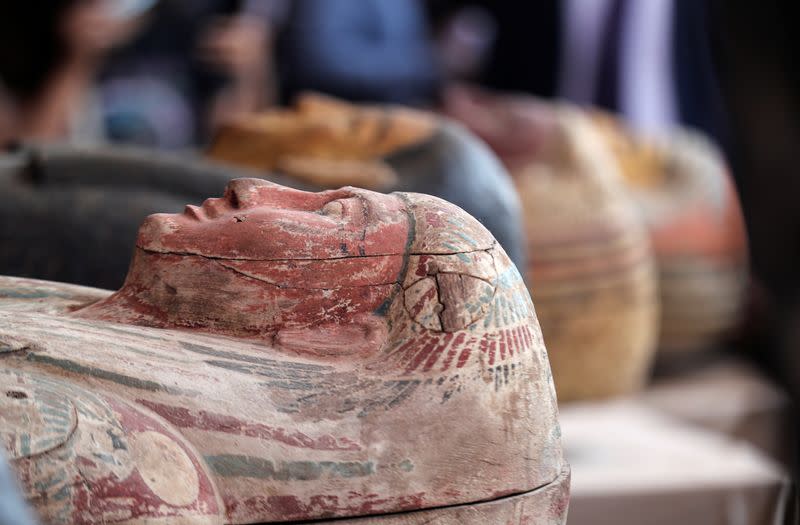
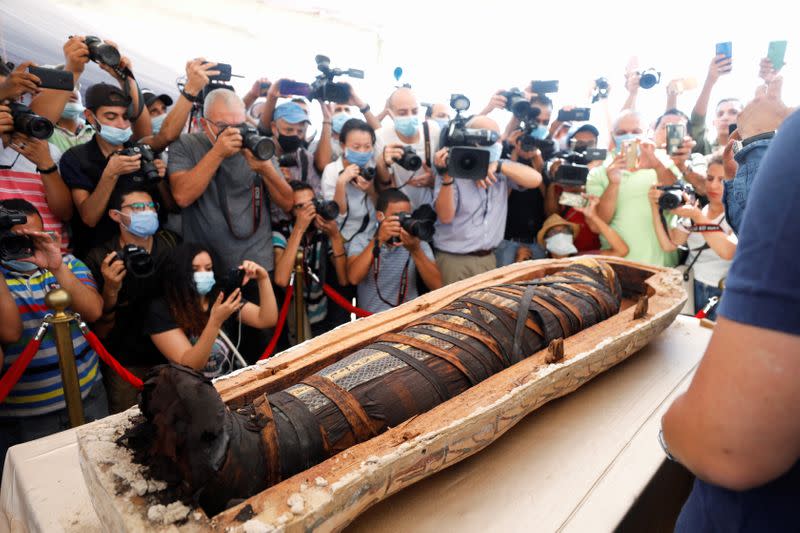
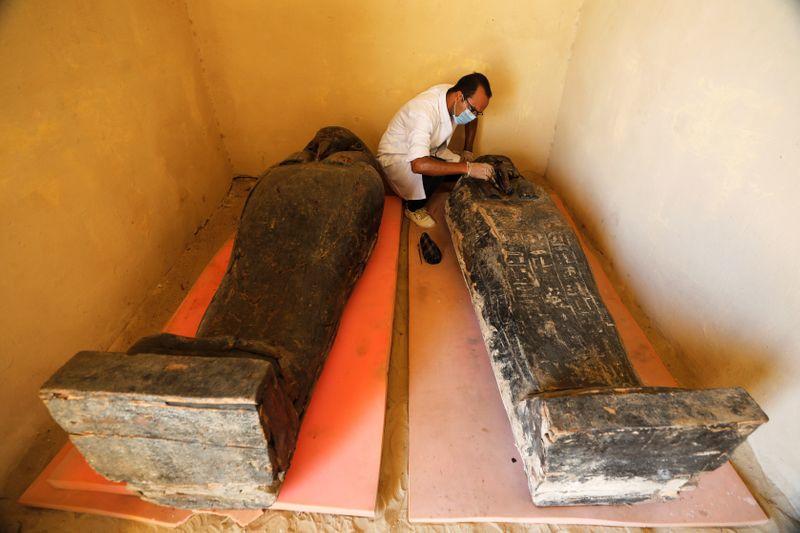
Egypt unveils 59 ancient coffins in major archaeological discovery
Newly discovered burial site near Egypt's Saqqara necropolis in Giza
CAIRO (Reuters) - Egypt on Saturday put on show dozens of coffins belonging to priests and clerks from the 26th dynasty nearly 2,500 years ago, with archaeologists saying tens more were found in the vast Saqqara necropolis just days ago.
The 59 coffins were discovered in August at the UNESCO world heritage site south of Cairo, buried in three 10-12 meter shafts along with 28 statues of the ancient Egyptian God Seker, one of the most important funerary deities.
They belonged to priests and clerks from the 26th dynasty, said Mostafa al-Waziri, secretary-general of Egypt’s Supreme Council of Antiquities.
The Egyptian archaeological mission behind the discovery had been active since 2018 and previously unveiled a cache of mummified animals and a well-preserved tomb of a fifth dynasty royal priest called 'Wahtye' in the area.
'
Mostafa Waziri, the general director of Egypt's Supreme Council of Antiquities, told NBC News that the find reminded him of the tomb of King Tutankhamun, because both had been discovered almost intact.
The Saqqara plateau is part of the necropolis of Egypt's ancient city of Memphis. Designated a UNESCO World Heritage site in 1970s, it includes the famed Giza Pyramids. It is also home to tombs created across thousands of years between the 1st Dynasty (2920 B.C.-2770 B.C.) and the Coptic period (395-642).
Hundreds of mummified animals, birds and crocodiles, as well as two mummified lion cubs were found in the region last year.
Egypt has heavily promoted new archaeological finds to international media and diplomats in recent years, in an effort to revive its tourism sector, which has suffered since the 2011 Arab Spring uprisings that toppled autocrat Hosni Mubarak.
The sector was dealt a further blow this year by the coronavirus pandemic.
Download the NBC News app for breaking news and politics
Last week, the ministry displayed a bronze statue of the god "Nefertam," one of the artifacts discovered with the ancient wooden coffins.
Inlaid with precious stones red agate, turquoise and lapis lazuli, it reached a height of 35 cm (14 in) and on its base is inscribed with the name of the owner of the statue, a priest called "Badi Amun."
"Saqqara antiquities area is still revealing its secrets," the ministry said.
Charlene Gubash reported from Saqqara and Adela Suliman from London.
The Associated Press contributed to this report
Egypt unveils 59 ancient coffins in major archaeological discovery
Reuters•October 3, 2020



Egypt unveils 59 ancient coffins in major archaeological discovery
Newly discovered burial site near Egypt's Saqqara necropolis in Giza
CAIRO (Reuters) - Egypt on Saturday put on show dozens of coffins belonging to priests and clerks from the 26th dynasty nearly 2,500 years ago, with archaeologists saying tens more were found in the vast Saqqara necropolis just days ago.
The 59 coffins were discovered in August at the UNESCO world heritage site south of Cairo, buried in three 10-12 meter shafts along with 28 statues of the ancient Egyptian God Seker, one of the most important funerary deities.
They belonged to priests and clerks from the 26th dynasty, said Mostafa al-Waziri, secretary-general of Egypt’s Supreme Council of Antiquities.
The Egyptian archaeological mission behind the discovery had been active since 2018 and previously unveiled a cache of mummified animals and a well-preserved tomb of a fifth dynasty royal priest called 'Wahtye' in the area.
'
Waziri explained the team had uncovered the three shafts where the coffins were laid in "perfect condition" due to a protective seal that preserved them from chemical reactions.
The mission will continue opening the coffins and studying their contents before their eventual display at the Grand Egyptian Museum, expected to open next year.
The mission will continue opening the coffins and studying their contents before their eventual display at the Grand Egyptian Museum, expected to open next year.
(Reporting by Ahmed Fahmy; Writing by Seham Eloraby; Editing by Nadine Awadalla and Clelia Oziel)


No comments:
Post a Comment